Merging quality improvement efforts with real-time data
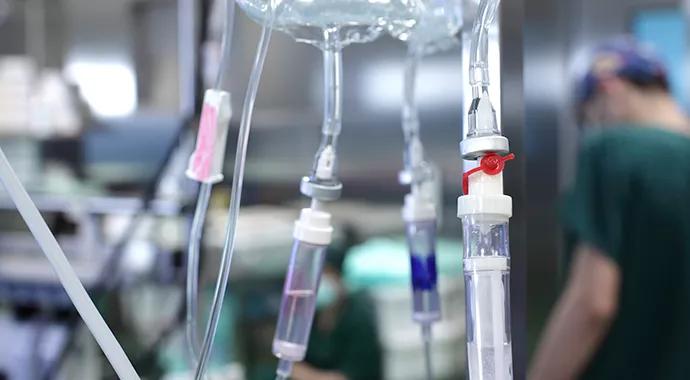
By Charles B. Foster, MD, and Ritika Coelho, MD
Cleveland Clinic is a non-profit academic medical center. Advertising on our site helps support our mission. We do not endorse non-Cleveland Clinic products or services. Policy
Surgical site infections (SSIs) represent an important cause of healthcare-associated morbidity and mortality and are increasingly the focus of regulatory agencies and patient safety organizations. While national quality improvement initiatives like the Surgical Care Improvement Project have developed measures to reduce SSIs, these measures, including on-time delivery of preventive antibiotics, have not typically applied to patients younger than 18, resulting in inconsistent adoption by pediatric hospitals.1,2
Two measures important to the prevention of pediatric SSIs occurred in Ohio in the past few years. The first was a state mandate for public reporting of pediatric procedure-specific SSI rates. The second was the establishment of Ohio Children’s Hospitals’ Solutions for Patient Safety (OCHSPS), an innovative collaborative of eight children’s hospitals throughout Ohio to reduce healthcare-associated complications, including SSIs. Its success spawned formation of the Children’s Hospitals’ Solutions for Patient Safety National Children’s Network, a group of 80+ children’s hospitals with a similar mission at the national level.3
As part of the OCHSPS and in preparation for public reporting, Cleveland Clinic Children’s adopted a simple “SSI prevention bundle” that included the following primary components:
The bundle was later expanded to include a preoperative bath and receipt of an appropriately timed antibiotic redose. For the OCHSPS, hospitals were urged to perform mini root-cause analyses on all SSIs and to add components to their own SSI prevention bundles.
Around this time, our hospital experienced a cluster of SSIs in scoliosis surgery patients, mainly due to Propionibacterium acnes. Without performing a formal case-control study, we developed a standardized root-cause analysis form to identify possible risk factors. While our analysis indicated compliance with the core SSI prevention bundle recommended by the OCHSPS, additional risk factors were suggested, including:
In response, we implemented pediatric perioperative antibiotic dosing guidelines that increased weight-based doses and shortened intraoperative redosing intervals. We combined these with an enhanced surveillance and quality improvement program aimed at ensuring compliance. We initiated quality improvement projects to optimize the dose and timing of intraoperative antibiotics, with the goal of 100 percent compliance. The following changes were implemented:
To facilitate data collection for key process measures, we created the Pediatric Healthcare-Associated Infection (Peds HAI) Database to automate data extraction from the electronic medical record. This database, a collaboration with Cleveland Clinic’s Department of Quantitative Health Sciences, contains data from 2006 to the present and is refreshed nightly.
The database captures data on pediatric surgical procedures corresponding to over 750 CPT codes. For each procedure, data are retrieved from the Anesthesia Automated Record Keeping System database, operating room nursing databases (OpTime and ORIS) and Epic’s Clarity database (Epic’s data warehouse). Data are stored in a searchable Oracle Discoverer database.
Our Peds HAI Database is optimized to retrieve data on antibiotic timing and dosing for patients with CPT-encoded procedures related to cardiac, spine and neurological shunt surgeries. Report features facilitate automated counts of cases and generation of process data such as correct antibiotic timing, dosing and redosing. Further information (e.g., surgeon, anesthesiologist, type of implant, operating room number, blood loss) for a given procedure is retrievable on a case-by-case basis, enabling automated data collection for apparent or root-cause analyses.
We used the Peds HAI Database to track compliance with antibiotic timing and dosing in the pediatric orthopaedic spine population from 2006 to the present. For the antibiotic cefazolin, we track four key process measures:
As a testament to the power of quality improvement initiatives coupled with real-time data collection, in the third quarter of 2013 we achieved 100 percent compliance with all four metrics (Figure).
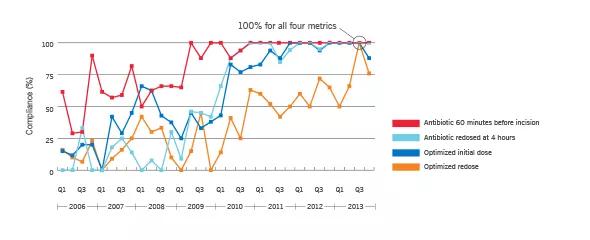
Figure. Quarterly rates of compliance with the four metrics tracked to ensure use of cefazolin at optimized doses and correct times for prophylaxis of surgical site infections in orthopaedic spine fusion procedures (N = 556).
The infection rate after orthopaedic spine procedures decreased from 9.9 percent in 2009 to 4.9 percent in 2010 to 2.1 percent in 2011 and to 2.7 percent in 2012 (P < .01 for 2009 vs. 2011-2012). Despite improved compliance with the weight-based dosing and redosing metrics, the infection rate in 2013 increased to 4.2 percent, suggesting that factors beyond optimized weight-based dosing may contribute to SSI risk.
We are now using the Peds HAI Database to perform a formal case-control study to test the hypothesis that a cefazolin-based perioperative dosing schedule with optimized weight-based doses and shortened redosing intervals reduces the risk of wound infections following pediatric spine surgery. It should soon be possible to track risk factors for SSIs in real time by linking our Peds HAI Database to outcomes data collected by the infection prevention team or inferred from surrogate markers for infection.
Dr. Foster is a staff physician in the Center for Pediatric Infectious Diseases at Cleveland Clinic Children’s.
Dr. Coelho is a pediatric infectious diseases fellow at Cleveland Clinic Children’s.

Consider offering your patients enrollment in a leading-edge clinical study
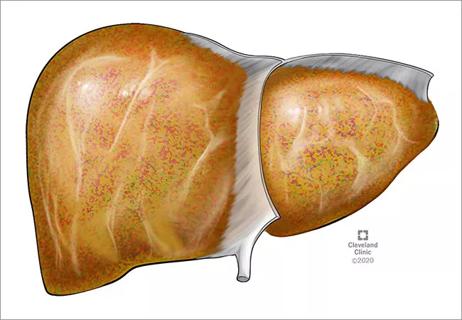
Findings underscore need for early screening and close follow-up

Consider offering your patients enrollment in a leading-edge clinical study
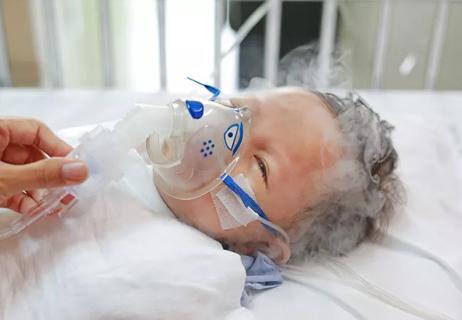
Titanium dioxide nanoparticles exaggerate inflammation induced by RSV
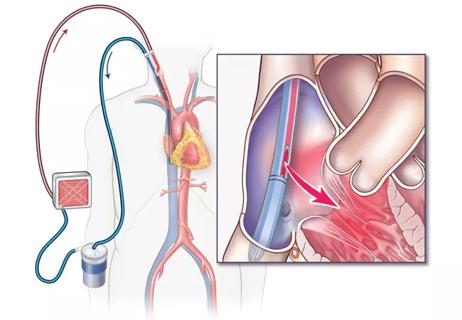
Study supports using the direct thrombin inhibitor

Estimating risk remains elusive

The search for predictive factors continues
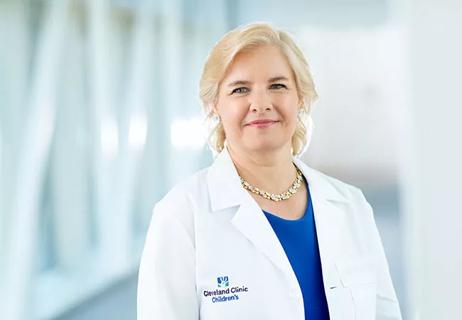
A conservation with Karen Murray, MD